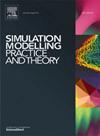A multi-agent system simulation of job shop scheduling with human consideration: A comparative analysis of AGVs and AIVs
IF 3.5
2区 计算机科学
Q2 COMPUTER SCIENCE, INTERDISCIPLINARY APPLICATIONS
引用次数: 0
Abstract
The manufacturing landscape is undergoing a paradigm shift towards Industry 5.0, emphasizing human-centricity in a collaborative environment between humans and robots. In this context, the job shop scheduling problem (JSSP) remains a critical aspect of workshop management, optimizing task sequencing to minimize the overall completion time (makespan). Traditionally, autonomous and guided vehicles (AGVs) have been employed for tasks transportation within workshops. However, their limited flexibility and reliance on dedicated pathways hinder seamless integration with human workers. Autonomous and intelligent vehicles (AIVs) emerge as a promising alternative, offering enhanced adaptability and the ability to navigate alongside humans in shared spaces. Despite the emphasis on human-centricity as a foundation of manufacturing in Industry 5.0, research explicitly considering human factors in JSSPs remains scarce. Hence, this study delves into the transition from AGVs to AIVs within the context of JSSP, evaluating their impact on the makespan and the influence of human presence on AIV operations. Employing a multi-agent system (MAS)-based simulation approach, we model the stochastic human behaviour using discrete-time Markov chains (DTMC) and investigate the impact of the interactions between AIVs and human workers within shared movement corridors. Our findings highlight the potential of AIVs to enhance workshop efficiency over AGVs, and their effectiveness in human-centred manufacturing policy, paving the way for more collaborative and adaptable production systems.
考虑人为因素的作业车间调度多智能体仿真:agv与aiv的比较分析
制造业正在经历向工业5.0的范式转变,强调在人与机器人之间的协作环境中以人为中心。在这种情况下,作业车间调度问题(JSSP)仍然是车间管理的一个关键方面,优化任务排序以最小化总体完成时间(makespan)。传统上,自动导引车(agv)被用于车间内的任务运输。然而,它们有限的灵活性和对专用通道的依赖阻碍了与人类工人的无缝融合。自动驾驶和智能车辆(aiv)作为一种很有前途的替代方案出现了,它们提供了更强的适应性和在共享空间中与人类一起导航的能力。尽管强调以人为中心是工业5.0中制造业的基础,但明确考虑jssp中人为因素的研究仍然很少。因此,本研究在JSSP的背景下深入研究了从agv到AIV的过渡,评估了它们对最大跨度的影响以及人类存在对AIV操作的影响。采用基于多智能体系统(MAS)的仿真方法,我们使用离散时间马尔可夫链(DTMC)对随机人类行为进行建模,并研究共享运动走廊内aiv与人类工人之间相互作用的影响。我们的研究结果强调了aiv在提高车间效率方面的潜力,以及它们在以人为中心的制造政策中的有效性,为更具协作性和适应性的生产系统铺平了道路。
本文章由计算机程序翻译,如有差异,请以英文原文为准。
求助全文
约1分钟内获得全文
求助全文
来源期刊

Simulation Modelling Practice and Theory
工程技术-计算机:跨学科应用
CiteScore
9.80
自引率
4.80%
发文量
142
审稿时长
21 days
期刊介绍:
The journal Simulation Modelling Practice and Theory provides a forum for original, high-quality papers dealing with any aspect of systems simulation and modelling.
The journal aims at being a reference and a powerful tool to all those professionally active and/or interested in the methods and applications of simulation. Submitted papers will be peer reviewed and must significantly contribute to modelling and simulation in general or use modelling and simulation in application areas.
Paper submission is solicited on:
• theoretical aspects of modelling and simulation including formal modelling, model-checking, random number generators, sensitivity analysis, variance reduction techniques, experimental design, meta-modelling, methods and algorithms for validation and verification, selection and comparison procedures etc.;
• methodology and application of modelling and simulation in any area, including computer systems, networks, real-time and embedded systems, mobile and intelligent agents, manufacturing and transportation systems, management, engineering, biomedical engineering, economics, ecology and environment, education, transaction handling, etc.;
• simulation languages and environments including those, specific to distributed computing, grid computing, high performance computers or computer networks, etc.;
• distributed and real-time simulation, simulation interoperability;
• tools for high performance computing simulation, including dedicated architectures and parallel computing.
 求助内容:
求助内容: 应助结果提醒方式:
应助结果提醒方式:


